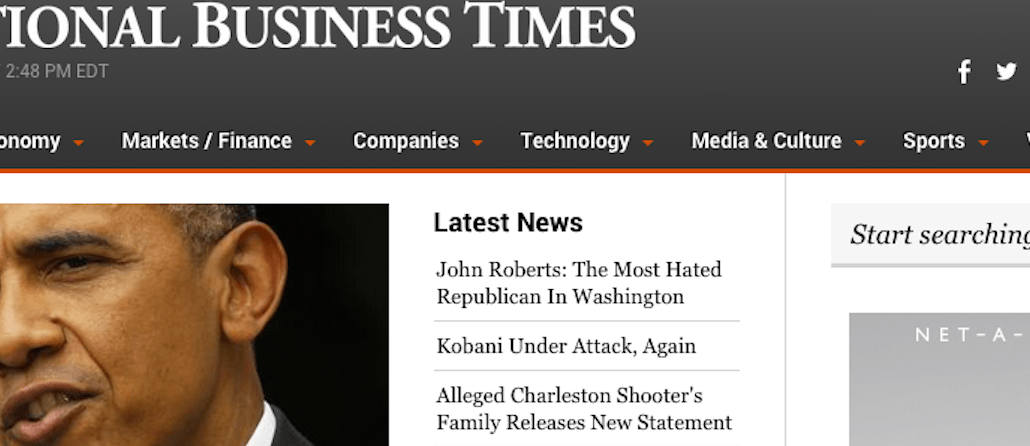
IBTimes was one of the fastest-growing business sites of the past year, up 38 percent to 21.5 million uniques, according to comScore. But it’s still unknown in ad circles.
The site is the flagship of IBT Media, an 8-year-old digital publishing company that many people first heard of when it bought the struggling Newsweek two years ago. IBTimes was a heavily aggregation- and search-driven site where writers were incentivized by traffic bonuses. Since then, it has made moves to bring respectability to the site. Under global editor-in-chief Peter Goodman, a vet of The New York Times and Huffington Post, the site has made about 45 editorial hires, including established journalists like David Sirota, Eric Markowitz and John Simons.
Goodman said they’ve helped make a mark with stories like Clinton Foundation Donors Got Weapons Deals From Hillary Clinton’s State Department, which got more than 30,000 likes on Facebook; and Why Two of America’s Biggest Prison Tech Companies Are Battling Over Patents.
Now, the site is turning its attention to the business side. It has just hired a chief marketing officer in Mitchell Caplan, formerly of McCann and Y&R. There are plans to hire as many as 50 people across sales, marketing, tech and analytics.
“We’ve made a lot of progress, and now it’s time to add that marketing varnish,” said Etienne Uzac, who founded the company with Johnathan Davis. “We’re very editorial-heavy right now.”
And varnish is wanting. The site has been working largely with ad networks, so most of the ads on the site are retargeted. The site makes ample use of that derided tactic, video ads that play continuously with the sound on. What sponsored content ads there are are programmatically powered by Nativo, a third-party native ad platform.
But programmatic has its limits, which is why the company is turning its focus to more lucrative direct sales. Along with that, it’s trying to capture more user-registration data, to enable better ad targeting. It acquired Fashion Times LLC in May to diversify its ad base.
“At the scale we have, there is a limited amount of revenue that can be generated through pipelines,” Uzac said. “There’s still a lot of money to be made from direct. We have a global viewpoint. So I think we’re going to be a great fit for international campaigns.”
Other publishers have had a couple years’ head start creating in-house units to attract advertisers’ branded content dollars, though. The hope for a new player like IBTimes is that it uses competitors’ missteps to come up with better products, said Brian Ko, managing partner for digital at MEC. Another way a publisher like IBTimes can differentiate is by using first-party data to build audience segments that are tied to purchase behavior and are of great value to advertisers, said Rick Ducey, managing director at BIA Kelsey.
Still, news is a crowded field, and the site’s high dependence on search and fleeting visits shows it has some work to do to make itself a regular destination for readers. IBTimes is following a familiar playbook among digital publishers in scaling an audience first with contributed or aggregated content, then increasing its hard-hitting and original journalism. But it becomes harder to build an editorial brand as news is increasingly filtered through social platforms and small screens.
According to comScore, Google is still IBTimes’ second-biggest single referral source after Yahoo, accounting for 11.3 percent of its desktop traffic. Less than 2 percent of traffic comes from Facebook. (It’s likely higher on mobile, where social is a big driver of traffic.)
Goodman said the site has grown its traffic by increasing its focus on the low-hanging fruit of digital publishing: round-the-clock news coverage, stories designed for sharing and TV recaps.
But he conceded that social isn’t growing as fast as he’d like. Part of the reason may be that the investigative stories on prisons don’t lend themselves to social sharing. It’s also hard to break through people’s social feeds. “It’s crowded out there,” he said. “People aren’t bookmarking sites much. It’s just a slow process of having people figure out that what we’re doing is consequential.”
Image courtesy of IBTimes.
More in Media

Digiday+ Research: Publishers’ growing focus on video doesn’t translate to social platforms
Major publishers have made recent investments in vertical video, but that shift is not carrying over to social media platforms.

Technology x humanity: A conversation with Dayforce’s Amy Capellanti-Wolf
Capellanti-Wolf shared insight on everything from navigating AI adoption and combating burnout to rethinking talent strategies.

How The Arena Group is rewriting its commercial playbook for the zero-click era
The company is testing AI-powered content recommendation models to keep readers moving through its network of sites and, in doing so, bump up revenue per session – its core performance metric.





